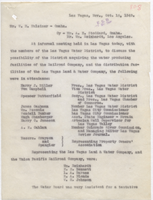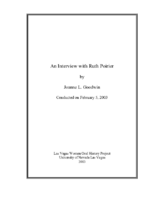Search the Special Collections and Archives Portal
Search Results

Correspondence from L. A. Barnes (Las Vegas) to W. H. Hulsizer (Omaha), October 12, 1949
Date
Archival Collection
Description
Summary notes of a meeting between the Las Vegas Valley Water District and the Las Vegas Land and Water Company regarding the possible sale of water production to the district.
Text
Kay Royer Red Cross Scrapbook
Identifier
Abstract
The Kay Royer Red Cross Scrapbook contains black-and-white photographic prints, newspaper clippings, and personal correspondence collected by Sarah "Kay" Royer while stationed at the 248th General Hospital and 4th General Hospital in the Philippines from 1945 to 1948. The scrapbook contains newspaper clippings with commentary written by Royer documenting her training at the American University in Washington, D.C., the journey to Manila, and her time spent there working in various hospitals. Included in the scrapbook are letters from soldiers thanking the nurses for their care, dance cards, menus from holidays and special occasions, and hand-drawn sketches given to Royer.
Archival Collection
Jeanne Russell Janish Photograph Collection
Identifier
Abstract
The Jeanne Russell Janish Photograph Collection (1918-1974) consists of 48 black-and-white and color photographic prints that feature Janish's family, her husband Carl Janish, family homes and pets, and travel photographs from the United States, China, and South America.
Archival Collection
Nevada Women's History Project Records
Identifier
Abstract
The Nevada Women's History Project Records (1995-2008) contain the early organizational records of the Nevada Women's History Project (NWHP), which was created to collect and disseminate information about women throughout Nevada's history. The collection reflects the early organization of the Nevada Women's History Project's (NWHP) Southern region and the variety of events and projects with which the organization was involved with across the state of Nevada. Materials include membership lists, meeting minutes, press releases, project files, and NWHP newsletters.
Archival Collection
Nita Longo Rieger Collection on the Desert Chapter of Gold Star Mothers
Identifier
Abstract
The Nita Longo Rieger Collection on the Desert Chapter of Gold Star Mothers consists of materials dated from 1947 until 1995 from the Desert Chapter of Gold Star Mothers Inc. located in Las Vegas, Nevada. It includes newspaper clippings about the group, a history of the chapter, photographs of meetings and member events, and programs from the dedication and rededication of a monument erected by the group.
Archival Collection
KNPR: "Monday Night Jazz" Program Documentation and Recordings
Identifier
Abstract
The KNPR: "Monday Night Jazz" Program Documentation and Recordings focus on jazz music played at the Four Queens Hotel and Casino in Las Vegas, Nevada from 1982 to 1997. The materials contain the reel-to-reel audio tapes from the radio programs that were taped at the Four Queens Hotel, including unedited master recordings and the edited versions played on air by Nevada National Public Radio (KNPR). Materials also include contracts, newspaper clippings, correspondence, photographs, and jazz scheduling information related to the program.
Archival Collection
Steve Round Memorial Book of the 1 October Shooting in Las Vegas
Identifier
Abstract
This collection is comprised of a memorial book filled with handwritten condolences, memorials, and prayers for the victims of the mass shooting that occurred on October 1, 2017 at the Route 91 Harvest music festival in Las Vegas, Nevada. From October 2-10, 2017, Steve Round watched over a memorial that spontaneously developed in the median of Las Vegas Boulevard near the site of the shooting. Round invited visitors at the memorial, including families and friends of the victims, community members, first responders, and tourists, to sign the book.
Archival Collection
Leon Rockwell Papers
Identifier
Abstract
The Leon Rockwell Papers (1829-1986), consist of materials that document Leon Rockwell's life in Las Vegas, Nevada from 1906 until his death in 1968. Included are diaries, correspondence, photographs, postcards, Las Vegas community event programs, ledger sheets, business cards, and scrapbooks. There are a number of books, information on organizations and businesses that Rockwell owned, real estate documents, and early records of the Las Vegas Volunteer Fire Department, of which Rockwell was an original member.
Archival Collection
A.E. Cahlan Newspaper Columns
Identifier
Abstract
The A. E. Cahlan Newspaper Columns (1930-1968) consists of scrapbooks containing a complete run of Cahlan's "From Where I Sit" editorial column that he wrote for the
Archival Collection

Transcript of interview with Ruth Poirier by Joanne Goodwin, February 5, 2003
Date
Archival Collection
Description
In 1927, a sixteen-year-old girl from Rockford, Illinois moved to New York City to play trumpet with the all-girl bands common from the 1920s through the end of World War II. During this period, which spanned Prohibition, the Great Depression, and World War II, all-girl bands came into their own in America. They were especially popular during the war, when most men were off fighting but people still needed and appreciated music. This was also a time when jazz and swing became wildly popular in this country. All-girl bands were able fill a niche left empty by men at war. Doris Eloise Pressler was born in Jamesville, Illinois on January 17, 1911 to Bertha Hendrich Pressler and Louis Pressler. Almost immediately after her birth, the Pressler family moved to Rockford, Illinois. Bertha was a teacher, a homemaker and mother. Louis did auto body hand-painting and also managed a bar. In addition, he played baritone saxophone and taught his daughter Doris to play trumpet. They both performed with hometown bands, playing churches, dances, and other social events. In 1927 at age sixteen, Doris left school, moved out of the family home, and went to work for Walgreens in downtown Rockford. In her free time she played music. Doris began her professional music career in 1927 as a trumpeter with the Gypsy Sweethearts in Rockford. That same year, she moved to New York, where she played in the only women’s band that ever performed at New York’s historic Roseland Ballroom. During the early 1930s, Doris performed with the Red Dominos, an all-girl band that was part of a variety show produced by E. K. Nadel. However, it was tough for girl musicians during the Depression. Few managers wanted to hire female players when so many men were out of work. Doris persevered, and through the 1940s, she traveled and played with other all-girl bands such as Annette Demon and her French Dolls and the Hollywood Debs. While Doris pursued her music career, a little girl in Wisconsin was learning to play the piano and trombone. Born on April 13, 1917, Ruth Poirier came from a musical family: her father John played drums and French horn, her brother drums and bassoon. John performed with the local Elks Club group, while Ruth and her brother played for their high school band. Ruth’s mother Mary had been a nurse, so when she finished high school Ruth decided to attend nursing school in Chicago. After a year, she returned home to Wisconsin and trained as a beautician. In 1939, Ruth answered a local ad for girl musicians and signed on as a trombonist with an all-girl band. Her first gig lasted only a month, the band dissolved, and she left to tour with Annette Demon and her French Dolls out of Milwaukee. While playing down South, Ruth met a fellow musician who became her lifelong companion, Doris Pressler. In July 1939, Ruth and Doris took off for Southern California. While living in Long Beach, Doris performed with bands at the 660 Club on the Pike, a well-known waterfront amusement park, and at the Waldorf Cellar. She also played a gig at Murphy’s, across from the Showboat in Las Vegas. Girl musicians began getting more jobs because the men were being called into military service. Ruth, a “Rosie the Riveter” during the war years, helped to build Navy fighter planes for Douglas Aircraft in El Segundo, California. After the war ended in 1945 women, whether “Rosie the Riveters” or band members, lost their jobs to the hordes of returning servicemen. Realizing that all-girl bands were “gonna go nowhere at all,” Doris had decided in the early 1940s to return to school and pursue studies in her second love, mathematics. She took classes in math and engineering at the University of Southern California, and then joined the Los Angeles County surveyors’ department as a civil engineer. After two years there, Doris transferred to the road department, where she worked until her retirement in 1974. Ruth returned to work as a beautician, running a shop out of her home. The Greater Los Angeles area contained an active gay and lesbian community both during and after the war. Doris and Ruth enjoyed a social life that included girls’ clubs such as Tess’s and drag clubs like the Flamingo. According to Ruth, these were “sitting-down, drinking places…and visiting. We had one club where they had dancing…. But then they let everybody in.” After the war, everybody just wanted to have fun, and Doris and Ruth enjoyed getting together with all types of friends in clubs and in private homes. During these at-home evenings, Doris and others would play popular music for everyone’s enjoyment. After their retirement to Las Vegas in 1974, Doris and Ruth were active in their local senior center. Doris played with the Las Vegas Senior Band for ten years, and Ruth worked in support of the band and the center. According to Ruth, Doris loved playing with the band, and enjoyed it more because she was retired and could devote herself to her playing. Doris Pressler and Ruth Poirier lived together through six decades of radical social change in America. From the rise of women musicians and workers outside the home, through the return of women to more “traditional” roles after World War II, and finally the revolution in women’s roles from the 1960s to the present, Doris and Ruth experienced it all. And through it all, they maintained a relationship that lasted for 62 years, until Doris’s death. According to Ruth, “I enjoyed my life. I never found anything wrong with . ... I think Doris would say the same."
Text
